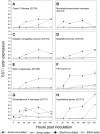Identification of differentially expressed genes in a resistant versus a susceptible blueberry cultivar after infection by Colletotrichum acutatum
- PMID: 21535352
- PMCID: PMC6640397
- DOI: 10.1111/j.1364-3703.2010.00687.x
Identification of differentially expressed genes in a resistant versus a susceptible blueberry cultivar after infection by Colletotrichum acutatum
Erratum in
-
Correction to 'Identification of differentially expressed genes in a resistant versus a susceptible blueberry cultivar after infection by Colletotrichum acutatum'.Mol Plant Pathol. 2024 Jul;25(7):e13495. doi: 10.1111/mpp.13495. Mol Plant Pathol. 2024. PMID: 38979977 Free PMC article. No abstract available.
Abstract
Anthracnose fruit rot, caused by the fungus Colletotrichum acutatum, is an important disease of blueberry worldwide. The cultivar Elliott is resistant, severely restricting fungal growth and sporulation relative to the susceptible cultivar Jersey. The objectives of this research were as follows: (i) to analyse pre-penetration events in 'Elliott' and 'Jersey' at different stages of fruit development; (ii) to identify putative defence genes in 'Elliott' fruit; and (iii) to monitor the timing of the oxidative burst in both cultivars. Light microscopy revealed no differences in the pre-penetration activities of C. acutatum on the immature fruit of both cultivars. However, at fruit ripening, conidia germinated and formed appressoria more rapidly on 'Jersey' than on 'Elliott' fruit. Using suppression subtractive hybridization, 37 differentially expressed sequence tags (ESTs) were detected in 'Elliott' versus 'Jersey' upon infection. Several of the ESTs had homology to known plant defence genes, such as a class II chitinase, pathogenesis-related protein 10 (PR10) and β-1,3-glucanase. Two putative genes involved in oxidative stress were identified: a metallothionein-like protein and monodehydroascorbate reductase. ESTs of fungal origin were also detected. Many ESTs had no homology to known genes. Using semi-quantitative and quantitative reverse transcription-polymerase chain reaction (RT-PCR), the expression of most of the candidate genes was detected earlier in 'Elliott' than in 'Jersey', some within 24 h post inoculation (hpi). Monitoring of the oxidative burst showed that the overall H(2) O(2) concentration was two to three times higher in 'Elliott' than in 'Jersey' at 24 hpi. The elucidation of the basis of resistance to C. acutatum in blueberry will facilitate the development of new anthracnose fruit rot-resistant cultivars.
© 2011 The Authors. Molecular Plant Pathology © 2011 BSPP and Blackwell Publishing Ltd.
Figures







Similar articles
-
Generation and analysis of blueberry transcriptome sequences from leaves, developing fruit, and flower buds from cold acclimation through deacclimation.BMC Plant Biol. 2012 Apr 2;12:46. doi: 10.1186/1471-2229-12-46. BMC Plant Biol. 2012. PMID: 22471859 Free PMC article.
-
Elucidation of the disease cycle of olive anthracnose caused by Colletotrichum acutatum.Phytopathology. 2009 May;99(5):548-56. doi: 10.1094/PHYTO-99-5-0548. Phytopathology. 2009. PMID: 19351251
-
Susceptibility of Olive Cultivars and Selections to Colletotrichum Species Causing Anthracnose in Spain.Plant Dis. 2025 Mar;109(3):683-690. doi: 10.1094/PDIS-02-24-0481-RE. Epub 2025 Mar 12. Plant Dis. 2025. PMID: 39393075
-
The mannose-binding lectin gene FaMBL1 is involved in the resistance of unripe strawberry fruits to Colletotrichum acutatum.Mol Plant Pathol. 2014 Oct;15(8):832-40. doi: 10.1111/mpp.12143. Epub 2014 May 7. Mol Plant Pathol. 2014. PMID: 24690196 Free PMC article.
-
First Report of Colletotrichum acutatum on Strawberry in Finland.Plant Dis. 2001 Aug;85(8):923. doi: 10.1094/PDIS.2001.85.8.923A. Plant Dis. 2001. PMID: 30823075
Cited by
-
Managing fruit rot diseases of Vaccinium corymbosum.Front Plant Sci. 2024 Aug 6;15:1428769. doi: 10.3389/fpls.2024.1428769. eCollection 2024. Front Plant Sci. 2024. PMID: 39166248 Free PMC article. Review.
-
Elucidation of the molecular responses during the primary infection of wild blueberry phenotypes with Monilinia vaccinii-corymbosi under field conditions.BMC Plant Biol. 2021 Oct 27;21(1):493. doi: 10.1186/s12870-021-03281-2. BMC Plant Biol. 2021. PMID: 34706657 Free PMC article.
-
Altered cultivar resistance of kimchi cabbage seedlings mediated by salicylic Acid, jasmonic Acid and ethylene.Plant Pathol J. 2014 Sep;30(3):323-9. doi: 10.5423/PPJ.NT.06.2014.0053. Plant Pathol J. 2014. PMID: 25289020 Free PMC article.
-
Molecular footprints of selection effects and whole genome duplication (WGD) events in three blueberry species: detected by transcriptome dataset.BMC Plant Biol. 2020 Jun 3;20(1):250. doi: 10.1186/s12870-020-02461-w. BMC Plant Biol. 2020. PMID: 32493212 Free PMC article.
-
Cassava (Manihot esculenta) transcriptome analysis in response to infection by the fungus Colletotrichum gloeosporioides using an oligonucleotide-DNA microarray.J Plant Res. 2016 Jul;129(4):711-726. doi: 10.1007/s10265-016-0828-x. Epub 2016 May 2. J Plant Res. 2016. PMID: 27138000
References
-
- Adaskaveg, J. and Hartin, R. (1997) Characterization of Colletotrichum acutatum isolates causing anthracnose of almond and peach in California. Phytopathology, 87, 979–987. - PubMed
-
- Afanador‐Kafuri, L. , Minz, D. , Maymon, M. and Freeman, S. (2003) Characterization of Colletotrichum isolates from tamarillo, passiflora, and mango in Colombia and identification of a unique species from the genus. Phytopathology, 93, 579–587. - PubMed
-
- Alkan, N. , Davydov, O. , Sagi, M. , Fluhr, R. and Prusky, D. (2009) Ammonium secretion by Colletotrichum coccodes activates host NADPH oxidase activity enhancing host cell death and fungal virulence in tomato fruits. Mol. Plant–Microbe Interact. 22, 1484–1491. - PubMed
-
- Anand, T. , Bhaskaran, R. , Raguchander, T. , Samiyappan, R. , Prakasam, V. and Gopalakrishnan, C. (2009) Defense responses of chili fruits to Colletotrichum capsici and Alternaria alternata . Biol. Plant. 53, 553–559.
-
- Arroyo, F.T. , Moreno, J. , García‐Herdugo, G. , Santos, B.D. , Barrau, C. , Porras, M. , Blanco, C. and Romero, F. (2005) Ultrastructure of the early stages of Colletotrichum acutatum infection of strawberry tissues. Can. J. Bot. 83, 491–500.
Publication types
MeSH terms
LinkOut - more resources
Full Text Sources

